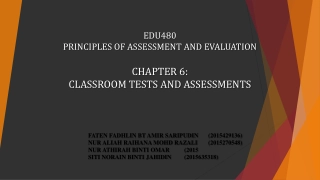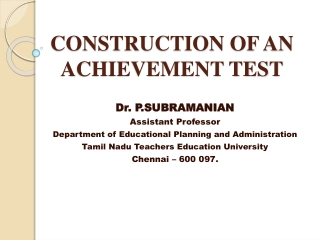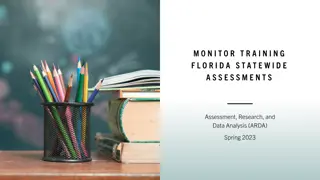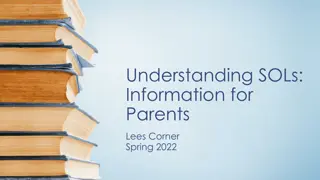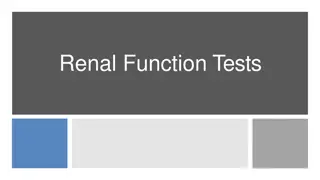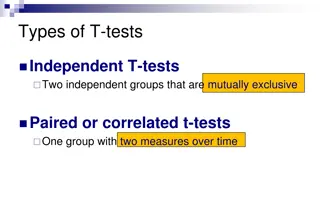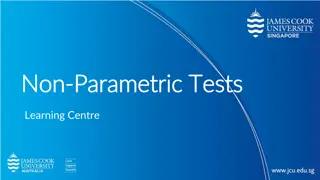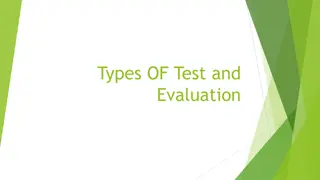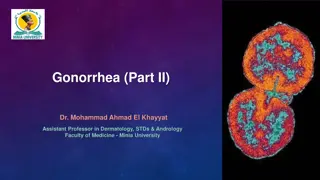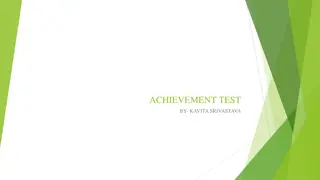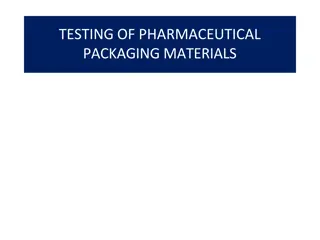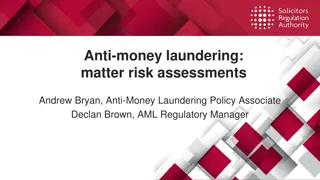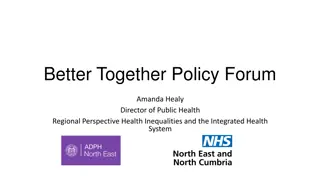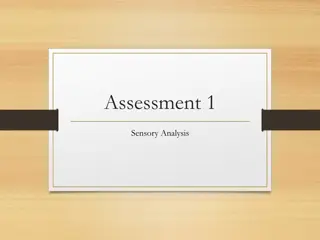Integrated Language Tests and Assessments Overview
This content delves into integrated language tests and assessments, exploring the differences between separate skills tests and integrated tests. It covers the rationale behind integrating language skills, examples of integrated skills tests, as well as shortcomings to avoid in test design. Key aspects such as the CEFR, interaction, mediation, reliability, and authenticity are discussed to provide a comprehensive understanding of integrated language assessment methods.
Download Presentation

Please find below an Image/Link to download the presentation.
The content on the website is provided AS IS for your information and personal use only. It may not be sold, licensed, or shared on other websites without obtaining consent from the author.If you encounter any issues during the download, it is possible that the publisher has removed the file from their server.
You are allowed to download the files provided on this website for personal or commercial use, subject to the condition that they are used lawfully. All files are the property of their respective owners.
The content on the website is provided AS IS for your information and personal use only. It may not be sold, licensed, or shared on other websites without obtaining consent from the author.
E N D
Presentation Transcript
Integrated Language Tests and Assessments What, Why and How Chris Smith ELTC University of Sheffield Chris.R.Smith@Sheffield.ac.uk
Overview What Why How Separate skills tests Integrated tests The CEFR Interaction Mediation Reliability and authenticity Texts Task design Ratings scales Scoring
Integrated Language Tests and Assessments What
Separate skills tests Traditional approach: Reading, Writing, Listening and Speaking were separate CLT appeared in late C20th 4-way split persists in testing Hinkel, E. (2010). Integrating the four skills: Current and historical perspectives. In R. B. Kaplan (Ed.), The Oxford Handbook of Applied Linguistics (2nd ed., pp. 110 126). Oxford: Oxford University Press.
Separate skills tests Usually some integration Usually negligible
Integrated skills tests examples Reading-into-writing (written text referencing sources) Written summary of a lecture Discussion (speaking, listening and interaction) Presentations (speaking based on academic reading)
Reading-into-writing examples Summarising a reading text and then responding to it Asenci n Delaney, Y. (2008). Investigating the reading-to-write construct. Journal of English for Academic Purposes, 7(3), 140 150. https://doi.org/10.1016/j.jeap.2008.04.001 Short opinion essay, incorporating ideas from two short reading texts Plakans, L. (2009). Discourse synthesis in integrated second language writing assessment. Language Testing, 26(4), 561 587. https://doi.org/10.1177/0265532209340192 Short answer questions (SAQs) about reading texts Weigle, S. C., Yang, W., & Montee, M. (2013). Exploring Reading Processes in an Academic Reading Test Using Short-Answer Questions. Language Assessment Quarterly, 10(1), 28 48. https://doi.org/10.1080/15434303.2012.750660 Reading-into-writing construct Knoch, U., & Sitajalabhorn, W. (2013). A closer look at integrated writing tasks: Towards a more focussed definition for assessment purposes. Assessing Writing, 18(4), 300 308. https://doi.org/10.1016/j.asw.2013.09.003
Integrated skills tests bad examples Discussion, but Criteria only consider individual production Reading-into-writing, but Minimal reading, token source inclusion Presentation, but Information source not assessed
Integrated skills tests An integrated language test/assessment is one in which 2 or more skills or modes are combined in a task, and where the result or report provides information on performance of those skills/modes (my definition)
Integrated Language Tests and Assessments Why
CEFR Common European Framework of Reference the CEFR replaces the traditional model of the four skills (listening, speaking, reading, writing), which has increasingly proved inadequate to capture the complex reality of communication...
CEFR Activities are presented under four modes of communication: reception, production, interaction and mediation Council of Europe. (2018). Common European Framework Of Reference For Languages: Learning, Teaching, Assessment Companion Volume With New Descriptors. Council of Europe Website. Retrieved from https://rm.coe.int/cefr-companion-volume-with-new-descriptors-2018/1680787989, p. 30
Communication Communication and interaction is how the capacity for language evolved in humans Communication is the root of all language Communicative competence should be included in a language test
Interaction Interaction is: dynamic and co-constructed, it evolves and emerges, and is shared between interlocutors. It is reciprocal and those involved are both pro-active and re-active at the same time, simultaneously deconstructing messages as listeners and constructing their own message as speakers Galaczi, E., & Taylor, L. (2018). Interactional Competence: Conceptualisations, Operationalisations, and Outstanding Questions. Language Assessment Quarterly, 15(3), 219 236. https://doi.org/10.1080/15434303.2018.1453816 (p. 219)
Mediation Mediating texts Mediating concepts Mediating communication Mediating texts Paraphrasing Note-taking (CoE, 2018, p. 104) (CoE, 2018, p. 104)
Mediation Mediation introduces an additional element: the construction of new meaning, in the sense of new understanding, new knowledge, new concepts. Piccardo, E., North, B., & Goodier, T. (2019). Broadening the scope of language education: mediation, plurilingualism, and collaborative learning: the cefr companion volume, 17 36. https://doi.org/10.20368/1971-8829/1612 (p. 21)
Integrated Language Tests and Assessments Why not?
UKVI EAP Assessments need to demonstrate that candidates are: proficient to level B2 on the Common European Framework of Reference for languages (CEFR) in each of the four components (speaking, listening, reading and writing) UKVI. (2019). Tier 4 of the Points Based System Policy Guidance. Retrieved March 6, 2019, from https://assets.publishing.service.gov.uk/government/uploads/system/uploads/attachment_data/file/770523/T4_Migrant_Guidance_JAN_2019_11.01.2 019.pdf (para. 142)
Solution Separate skills tests are not predicated Ensure the ratings scale demonstrates B2 in each of the 4 required skills Explain how in an assessment specifications document See Alderson, Clapham & Wall: Language Test Construction and Evaluation (Cambridge University Press, 1995), Chapter 2: Test Specifications
Reliability Integrated tests are less reliable (my colleague, J.) Essentially yes More variables, more factors, more difficult to pinpoint why performance is good or bad
Solution to the problem of reliability Constrain a test Minimise variables Remove messiness
Authenticity Tests should cover the construct Language is varied Communication is messy
Authenticity If language tests cut out the messiness in pursuit of better reliability, they may be cutting out essential aspects of language, leaving an incomplete test construct. If a test doesn t fully cover the target language use domain (TLUD), arguments for its reliability may be moot
Integrated language assessments: why? Traditional separate skills language tests do not capture the full nature of language Integrated tests include more in the construct Yes, the results may be less reliable Authenticity may be more important
Integrated Language Tests and Assessments How
Texts Adapt authentic texts Control for length and difficulty Use glossaries Allow time
Tasks Ensure task requires engagement with different skills/modes Opinion essay with token quotes Summary and comparison of texts
Ratings scales Different skills/modes must be on rating scale
Reading-into-writing scale Reading Comprehension of source texts Mediation Paraphrasing, Criticality Writing Cohesion, grammar, task achievement
Discussion scale Listening Comprehension of others Interaction Initiating, turn-taking, backchannelling Speaking Pronunciation, grammar, lexis
Lecture summary and response task Listening Comprehension of main ideas, Comprehension of details Mediation Summarising, commentary Writing Grammar, organisation
Problem areas Lexis Lexis is provided in source texts Comprehension of texts Less direct, less certainty Poor performance More difficult to pinpoint reason
Summary What Why How Separate skills tests Integrated tests The CEFR Interaction Mediation Reliability and authenticity Texts Task design Ratings scales Scoring
Integrated Language Tests and Assessments What, Why and How Chris Smith ELTC University of Sheffield Chris.R.Smith@Sheffield.ac.uk




